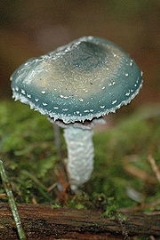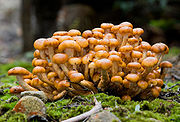
Strophariaceae
Encyclopedia
The Strophariaceae are a family
of fungi in the order Agaricales
. The family contains 18 genera
and 1316 species
. The species of Strophariaceae have a red-brown to dark brown spore print
, while the spores themselves are smooth and have an apical germ pore
. These agarics are also characterized by having a cutis-type pileipellis
. Ecologically, all species in this group are saprotrophs, growing on various kinds of decaying organic matter.

Family
In human context, a family is a group of people affiliated by consanguinity, affinity, or co-residence. In most societies it is the principal institution for the socialization of children...
of fungi in the order Agaricales
Agaricales
The fungal order Agaricales, also known as gilled mushrooms , or euagarics, contains some of the most familiar types of mushrooms. The order has 33 extant families, 413 genera, and over 13000 described species, along with five extinct genera known only from the fossil record...
. The family contains 18 genera
Genera
Genera is a commercial operating system and development environment for Lisp machines developed by Symbolics. It is essentially a fork of an earlier operating system originating on the MIT AI Lab's Lisp machines which Symbolics had used in common with LMI and Texas Instruments...
and 1316 species
Species
In biology, a species is one of the basic units of biological classification and a taxonomic rank. A species is often defined as a group of organisms capable of interbreeding and producing fertile offspring. While in many cases this definition is adequate, more precise or differing measures are...
. The species of Strophariaceae have a red-brown to dark brown spore print
Spore print
thumb|300px|right|Making a spore print of the mushroom Volvariella volvacea shown in composite: mushroom cap laid on white and dark paper; cap removed after 24 hours showing pinkish-tan spore print...
, while the spores themselves are smooth and have an apical germ pore
Germ pore
A germ pore is a small pore in the outer wall of a fungal spore through which the germ tube exits upon germination. It can be apical or eccentric in its location, and, on light microscopy, may be visualized as a lighter coloured area on the cell wall....
. These agarics are also characterized by having a cutis-type pileipellis
Pileipellis
thumb|300px||right|The cuticle of some mushrooms, such as [[Russula mustelina]] shown here, can be peeled from the cap, and may be useful as an identification feature....
. Ecologically, all species in this group are saprotrophs, growing on various kinds of decaying organic matter.
Genera

- The genus StrophariaStrophariaThe genus Stropharia is a group of medium to large agarics with a distinct membranous ring on the stipe. The scientific name is derived from the Greek 'στροφος/strophos' meaning "belt", in reference to it...
, is mainly a medium to large agaricAgaricAn agaric is a type of fungal fruiting body characterized by the presence of a pileus that is clearly differentiated from the stipe , with lamellae on the underside of the pileus. "Agaric" can also refer to a basidiomycete species characterized by an agaric-type fruiting body...
with a distinct membranous annulus. Spore printSpore printthumb|300px|right|Making a spore print of the mushroom Volvariella volvacea shown in composite: mushroom cap laid on white and dark paper; cap removed after 24 hours showing pinkish-tan spore print...
-color is generally medium to dark purple-brown, except for a few species that have rusty-brown spores. There is a great deal of variation, however, since this groups as presently delimited is polyphyletic. Members of the core clade of Stropharia are characterized by crystalline acanthocytes among the hyphae that make up the rhizoids at the base of the mushroom.
- The genus HypholomaHypholomaFungi of the genus Hypholoma are quite well known due to the commonness of Sulphur Tuft on stumps in temperate woodlands. This species is easily recognizable because the dark spores create a distinctive greenish effect on the yellow cap underside...
(formerly Naematoloma), is mainly a saprobe on wood and often grows in caespitose clusters. Spore printSpore printthumb|300px|right|Making a spore print of the mushroom Volvariella volvacea shown in composite: mushroom cap laid on white and dark paper; cap removed after 24 hours showing pinkish-tan spore print...
varies from medium brown to purple brown. These species all share a subcutaneous layer of inflated cells.
- The genus PholiotaPholiotaPholiota is a genus of small to fleshy mushrooms in the family Strophariaceae. The genus has a widespread distribution, especially in temperate regions, and contains about 150 species....
is characterized by a dull brown to cinnamon brown spore print. A well-known edible species is the Japanese NamekoNameko (plant)Pholiota nameko, commonly known as Nameko, is a small, amber-brown mushroom with a slightly gelatinous coating that is used as an ingredient in miso soup and nabemono. In some countries this mushroom is available in kit form and can be grown at home...
mushroom (Pholiota nameko)
- The genus PsilocybePsilocybePsilocybe is a genus of small mushrooms growing worldwide. This genus is best known for its species with psychedelic or hallucinogenic properties, widely known as "magic mushrooms", though the majority of species do not contain hallucinogenic compounds...
is well-known for its psychedelic mushroomPsychedelic mushroomPsilocybin mushrooms are fungi that contain the psychoactive compounds psilocybin and psilocin. There are multiple colloquial terms for psilocybin mushrooms, the most common being shrooms or magic mushrooms....
s, such as Psilocybe cubensisPsilocybe cubensisPsilocybe cubensis is a species of psychedelic mushroom whose principal active compounds are psilocybin and psilocin. Commonly called Boomers, Cubes or Gold Caps, it belongs to the Strophariaceae family of fungi and was previously known as Stropharia cubensis.-Taxonomy and naming:The species was...
. The blue-staining hallucinogenic species of Psilocybe and the non-bluing species of this genus are not directly related to one another, making this genus polyphyletic. Unlike most groups within the Strophariaceae, Psilocybe do not have chrysocystidia on the surface of their lamellae.

